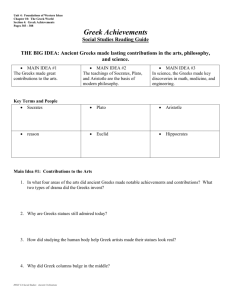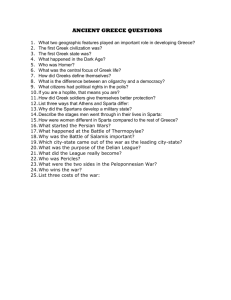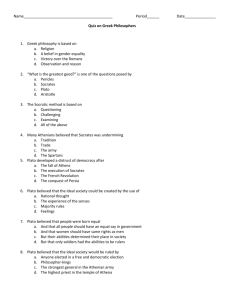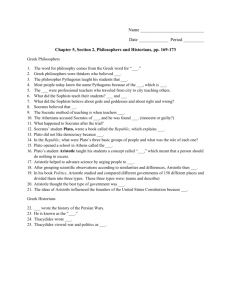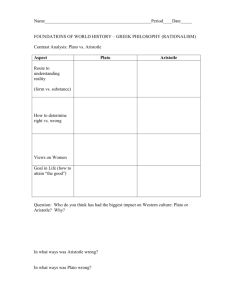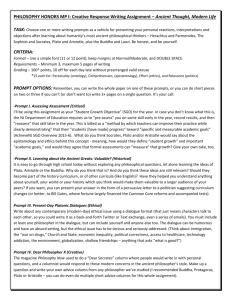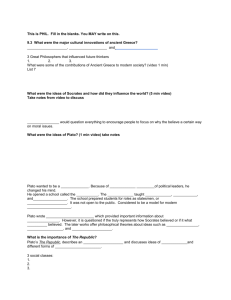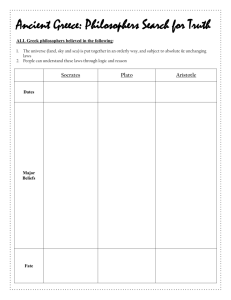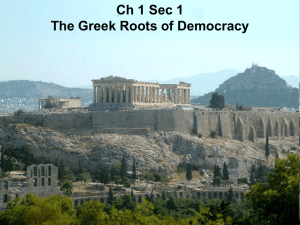Ancient Greece Assignments
advertisement
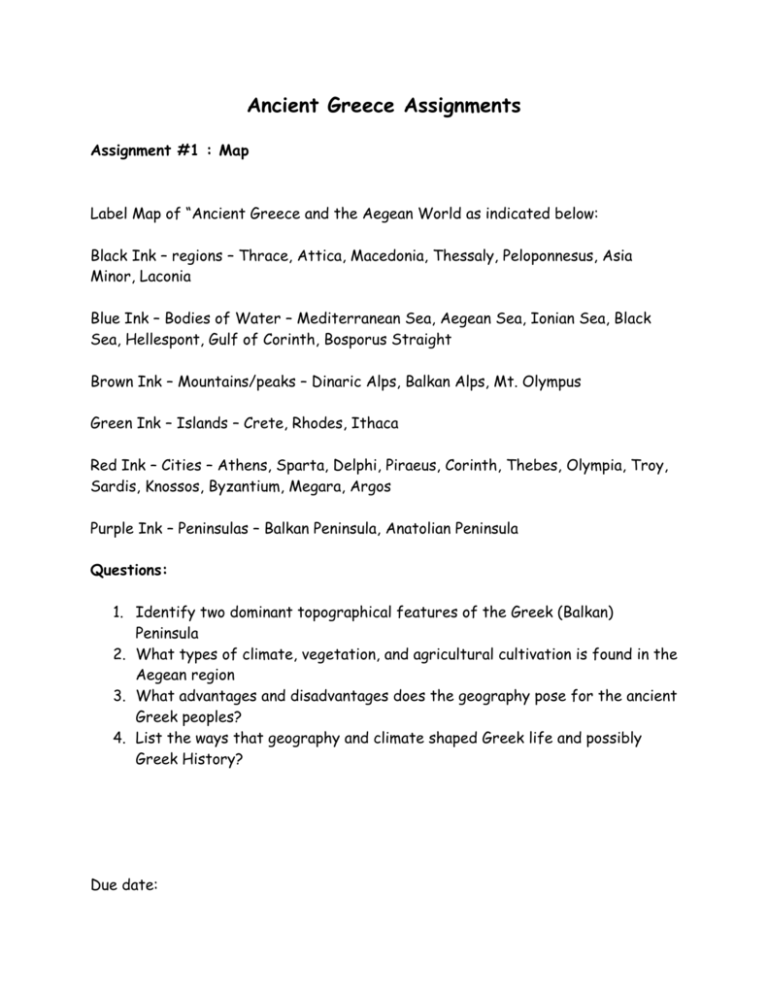
Ancient Greece Assignments Assignment #1 : Map Label Map of “Ancient Greece and the Aegean World as indicated below: Black Ink – regions – Thrace, Attica, Macedonia, Thessaly, Peloponnesus, Asia Minor, Laconia Blue Ink – Bodies of Water – Mediterranean Sea, Aegean Sea, Ionian Sea, Black Sea, Hellespont, Gulf of Corinth, Bosporus Straight Brown Ink – Mountains/peaks – Dinaric Alps, Balkan Alps, Mt. Olympus Green Ink – Islands – Crete, Rhodes, Ithaca Red Ink – Cities – Athens, Sparta, Delphi, Piraeus, Corinth, Thebes, Olympia, Troy, Sardis, Knossos, Byzantium, Megara, Argos Purple Ink – Peninsulas – Balkan Peninsula, Anatolian Peninsula Questions: 1. Identify two dominant topographical features of the Greek (Balkan) Peninsula 2. What types of climate, vegetation, and agricultural cultivation is found in the Aegean region 3. What advantages and disadvantages does the geography pose for the ancient Greek peoples? 4. List the ways that geography and climate shaped Greek life and possibly Greek History? Due date: Assignment #2 : Ancient Sparta Reading and Athens reading 1. 2. 3. 4. 5. 6. 7. 8. 9. What is a polis? Identify some general characteristics Identify different ways the polis could be governed. How did the Spartans achieve the domination of the Peloponnesus? Why did the city-state of Sparta develop into a military state? What skills were required of an Athenian citizen? What subjects were taught to Athenian boys? Girls? What were the military requirements for Athenian men/boys? What were the characteristics of the “Greek Ideal”? Fill out the Venn diagram to compare and contrast Athens and Sparta. Due Date: Assignment #3 : Religion of Ancient Greeks /Greek Art reading 1. Make a list of the major characteristics/beliefs of the religion of the ancient Greeks. 2. How was it different in emphasis from Judaism? Form Confucianism? Form Christianity? 3. What was the ancient Greek view of the afterlife? How did it change over time? 4. What does it mean when something is called “classic”? 5. Make a list of the major characteristics of classical Greek art and architecture. 6. In your opinion, what three words could be used to describe the values of the ancient Greeks that are reflected in their art and architecture? 7. What is meant by the “Golden Mean”, according to the ancient Greeks? Due: Assignment #4: excerpt from Sophocles play, Antigone 1. Why was Herodotus called the “Father of History?” 2. Why could it be argued that Thucydides more rightly deserved that title? 3. What was the original purpose of the Greek drama? 4. Why does Antigone feel that she was justified in breaking the law? Does an individual have a moral right to break laws that he/she thinks are unjust? Defend your position. Due: Assignment #5: Plato, Aristotle, and Socrates 1. Why didn’t Socrates write any of his ideas down himself? 2. What is the only thing that Socrates admits he “knows?” 3. What were Socrates basic principles of philosophy outlined by Plato in “The Apology”? 4. What does Plato mean when he talks about the world of Forms? 5. What I justice? Who defines its meaning? 6. How does Socrates challenge this definition, according to Plato? 7. Into which groups does Plato divide human beings? What is Plato’s criteria for this division? 8. Who rules the ideal society? 9. Why does Plato feel that a democracy is not the ideal form of government? 10. According to Aristotle, how do we know that something is “true”? 11. What are the four things that cause motion and change in the universe, according to Aristotle? 12. Why does Aristotle feel it is harder to be certain about the truth of major ethical principles? 13. How does Aristotle resolve this problem? 14. How are Aristotle’s, Plato’s, and Socrates philosophies fundamentally different? Due:
